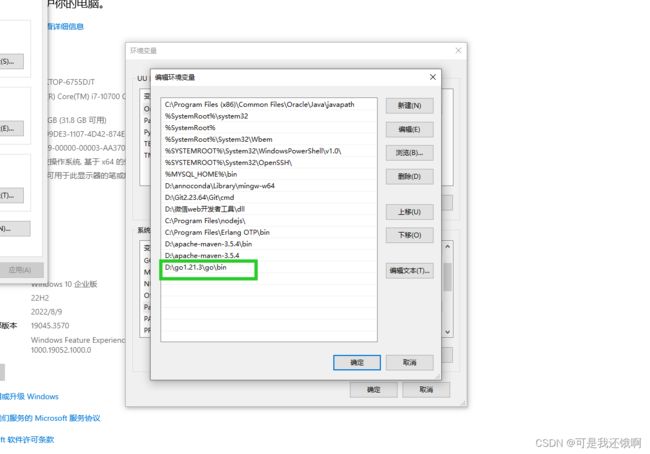GoLang开发使用gin框架搭建web程序
目录
1.SDK安装
2.编辑器下载
3.编辑器准备
4.使用
4.1常见请求方式
1.SDK安装
保证装了Golang的sdk(官网下载windows.zip->解压,安装,配置bin的环境变量)
2.编辑器下载
Download GoLand: A Go IDE with extended support for JavaScript, TypeScript, and databases (jetbrains.com)
3.编辑器准备
新建mod和一个main.go,打开命令行,拉取gin,下载慢配置阿里云镜像
配置阿里云镜像dos:go env -w GOPROXY=https://goproxy.io
拉取gin框架的dos: go get -u github.com/gin-gonic/gin
配置settings
4.使用
下载完导入下载的包,编写简单的get接口
package main
import (
"github.com/gin-gonic/gin"
)
func main() {
// 创建一个服务
ginServer := gin.Default()
// 访问地址,处理我们的请求 Request Response
ginServer.GET("/hello", func(context *gin.Context) {
// 给前端相应json数据
context.JSON(200, gin.H{"msg": "hello,world"})
})
// 服务器端口
err := ginServer.Run(":8082")
if err != nil {
return
}
}
验证
4.1常见请求方式
Go支持resfulAPI post get put delete...
下边测试一个post
package main
import (
"github.com/gin-gonic/gin"
)
func main() {
// 创建一个服务
ginServer := gin.Default()
ginServer.Use()
//连接数据库的代码
// 访问地址,处理我们的请求 Request Response
ginServer.GET("/hello", func(context *gin.Context) {
// 给前端相应json数据
context.JSON(200, gin.H{"msg": "hello,world"})
})
ginServer.POST("/user", func(context *gin.Context) {
context.JSON(200, gin.H{"msg": "hello,post"})
})
// 服务器端口
err := ginServer.Run(":8082")
if err != nil {
return
}
}
前后端传递值:前端传递JSON数据
package main
import (
"encoding/json"
"github.com/gin-gonic/gin"
"net/http"
)
func main() {
// 创建一个服务
ginServer := gin.Default()
ginServer.Use()
//前端给后端传递json
ginServer.POST("/json", func(context *gin.Context) {
//request.body
// 该方法返回的是一个切片[]byte,把切片包装成我们想要的对象
b, _ := context.GetRawData()
//go 语言的object可以用空接口来表示,可以接收一切事物
var m map[string]interface{}
// json解析 这里包装成map
_ = json.Unmarshal(b, &m)
// 返回前端json数据
context.JSON(http.StatusOK, m)
})
// 服务器端口
err := ginServer.Run(":8082")
if err != nil {
return
}
}
前后端传值,前端提交表单
package main
import (
"encoding/json"
"github.com/gin-gonic/gin"
"net/http"
)
func main() {
// 创建一个服务
ginServer := gin.Default()
ginServer.Use()
//前端提交表单
ginServer.POST("/user/add", func(context *gin.Context) {
username := context.PostForm("username")
password := context.PostForm("password")
context.JSON(http.StatusOK, gin.H{
"username": username,
"password": password,
})
})
// 服务器端口
err := ginServer.Run(":8082")
if err != nil {
return
}
}
验证
路由、404、路由组
//路由
ginServer.GET("/test", func(context *gin.Context) {
context.Redirect(http.StatusMovedPermanently, "http://www.baidu.com")
})
// 404
ginServer.NoRoute(func(context *gin.Context) {
context.HTML(http.StatusNotFound, "404.html", nil)
})
//路由组
userGroup := ginServer.Group("/user")
{
userGroup.GET("add")
}
orderGroup := ginServer.Group("/order")
{
orderGroup.GET("/delect", func(context *gin.Context) {
context.JSON(http.StatusOK,gin.H{
"msg":"删除操作",
})
})
}中间件(拦截器)
//自定义Go中间件 拦截器
func handler() gin.HandlerFunc {
return func(context *gin.Context) {
// 通过自定义的中间件,设置的值,在后续处理只要调用了这个中间件的都可以拿到这里的参数
context.Set("userSession","userid-1")
// 判断
//......
context.Next() // 放过
context.Abort() // 拦截
}
}使用
找一个方法,把拦截器名字作为参数放入
ginServer.GET("/user/info",myHandler(), func(context *gin.Context) {
// 取出中间件中的值
userSession := context.MustGet("userSession").(string)
userid := context.Query("userid")
username := context.Query("username")
context.JSON(http.StatusOK, gin.H{
"userid": userid,
"username": username,
"userSession":userSession,
})
})验证
多线程
package main
import (
"fmt"
"time"
)
func main() {
// go的多线程-协程
go printgogogo()
for i := 0; i < 1000; i++ {
fmt.Println("main", i)
}
time.Sleep(time.Second * 3)
}
func printgogogo() {
for i := 1; i < 1000; i++ {
fmt.Println("printgogogogo", i)
}
}







